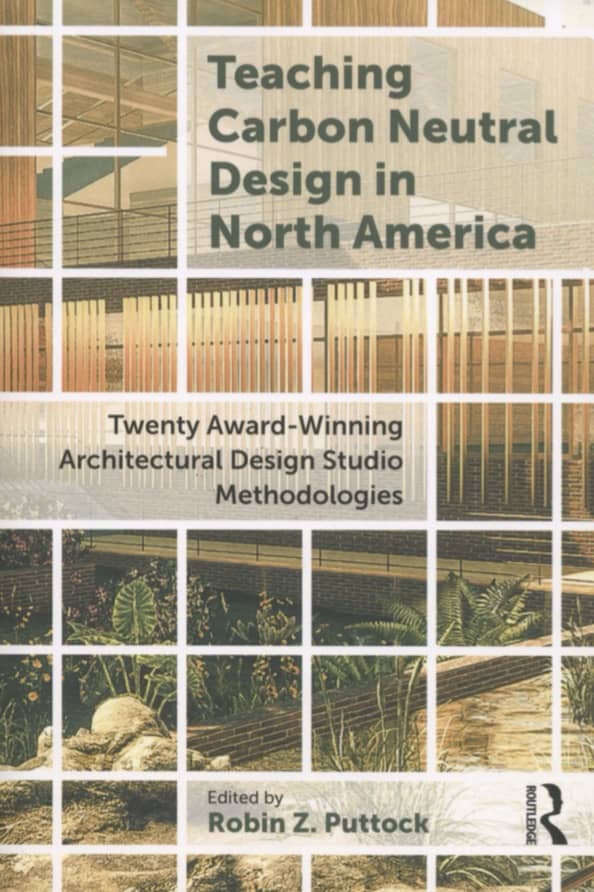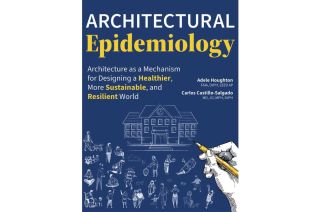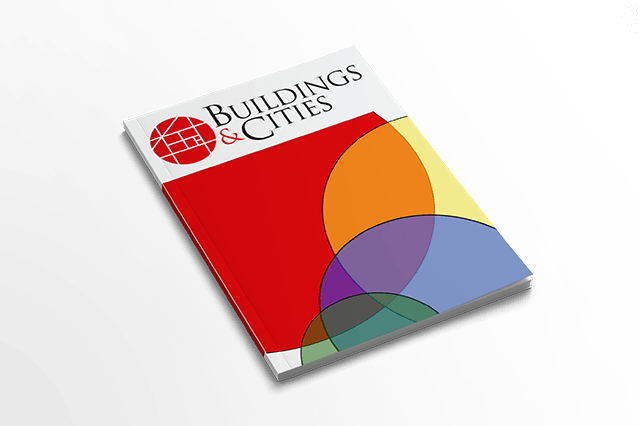
www.buildingsandcities.org/insights/reviews/teaching_carbon_neutral.html
Teaching Carbon Neutral Design in North America
Edited by Robin Puttock. Routledge, 2025, ISBN: 9781032692517
Richard Graves highly praises this book, which is not only a must-read for professors and students of architecture committed to a new practice connecting sustainability performance and design excellence, but also for the broader audience of architectural practitioners who would like a window on experiments for future practice.

Teaching Carbon Neutral Design in North America is a welcome contribution to the field of architecture specifically and climate education/action broadly. It is a hopeful book in the spirit of David Orr’s (2007) definition of hope as 'the sleeves rolled up…' to do the work to make a difference, despite there being few reasons for optimism. Action on climate change is supported by 86% of the population globally and this number is above 70% in the US and Canada, where the universities in the book are located and the perception is that this is not a popular opinion (Andre et al. 2025). As Puttock states, the goal of this book is to increase adoption of curricula that embrace:
'educating future graduates to combat the climate crisis through carbon neutral design.' (p. 1)
More schools of architecture need to include carbon neutral design, technology and theory into their curricula, but more importantly to integrate these ideas in substantive, supported and in-depth architectural exploration across the discipline.
Many faculty and students in architecture schools could feel that they are alone in their desire to integrate the commitment for climate action into a passionate pursuit of design. They are confronted with a challenge: could learning about the science and technology of energy and carbon aspects of the built environment degrade the lofty aspirations of proportion, order and space in the art of architecture? The inclusion of carbon neutral design is perceived to be a real risk in architecture programs. If poorly executed, it could degrade into a scientific exercise in dissecting the built environment into easily analysed parts that if fixed, solved and put back together will save humanity. However, if done well and created as a beautiful whole programme where architecture demonstrates design excellence, environmental performance and social relevance/impact, the hope for the future of architecture could transform into optimism.
Fortunately, many of the chapters in this book (e.g. Jonathan Bean’s Boxes and Doxa: Learning from the Solar Decathlon Design Challenge and Robert Fryer and Rob Fleming’s A Radical Transformative Student-Centered Approach to the Design of Net-Zero Buildings) interrogate the discipline of architecture. The cross-cutting theme of asking more of the discipline of architecture is very inspiring. The book digs into the details of process, tools and representing deep environmental design explorations. These studios demonstrate future-practice components and models for the profession.
Fryer and Fleming’s chapter critiques the 'normal' design process in architectural studios (and in architectural practices). This design process involves design research to investigate important bioclimatic constraints and opportunities, related technologies and design strategies. The research/analysis phase then moves to design expression that may or may not be connected. As a result, there is limited accountability for the final design that is executed with last-minute greening to give the impression of 'sustainability'. The results of the normal design process are architectural projects that range from complete ignorance of the environmental and social context to shallow greenwashing with little substance, to deeply regenerative design catalysts in systems. To address this problem, the authors propose a design process that connects the research and analysis of environmental and social factors to net-zero design. This involves assessing and measuring scenarios against specific goals to facilitate a design expression with a higher probability of impact of transformative energy/carbon system change. Examples and experimentation in performance-driven design processes are a welcome central theme of the book. Architecture schools, faculty, students, practitioners and then general public can learn critical lessons about transformative design that connects process and performance.
Performance metrics are another key theme of the book. Erica Cochran Hameen and Bihar Pathak’s chapter The Building as a Teaching Tool for Science, Technology, Engineering, Architecture and Math connects an array of disciplines and performance analytics to a very successful design studio. Students research structural systems, energy design, daylighting, water and other environmental aspects into an integrated design studio. This is particularly impressive because connecting carbon neutral design to integrated design studios is essential in architectural curricula. These types of studios are the foundation of architecture school accreditation and the future of practice. The example from Carnegie Mellon University is a reflection of many of the other schools in the book that organise students in collaborative work on carbon-neutral design that prepares then for professional practice in a dynamic future.
Other examples in the book explore integrating performance metrics into design, e.g. Ulrike Passe’s chapter Integrating Climate-Based Passive Design Strategies into Studio Pedagogy Towards Sustainable Net-Zero Carbon Buildings and William W. Braham and Billie Faircloth’s Environmental Building Design Research Studio: Design Innovation for the Climate Emergency. As Passe states:
'buildings are complex socio-technical entities, embedded in a social-cultural-economic-climatic context, and carbon or energy cannot be considered in isolation.' (p. 88)
The example of Passe’s studio demonstrates connections between bioclimatic analysis, site-specific context diagramming and rigorous modeling to influence design scenarios. Braham and Faircloth’s chapter outlines a design pedagogy connecting operational energy/carbon performance with embodied carbon aspects of materials in a studio project that adapts an existing building for resistance to extreme heat in the future. Any architectural studio professor would be proud of the formal results of the course with numerous student examples connecting the formal aspects of climate adaptation to demonstrable metrics of performance.
Other themes that are deftly explored are community engagement and interdisciplinary collaboration. Both themes are critical for the future of architecture. Why? They assist in connecting architecture to social and ecological systems (community engagement) with rigorous research and exploration in collaboration with engineering, social science, ecology and other disciplines. Many of the examples in the book experiment with these themes in the architectural courses explored. The most successful models demonstrate potential of architecture as a process to facilitate design with communities. Based upon deep research, this process integrates architectural projects that emerge as catalysts for 1 change. Architects want to design wonderful holistic environments and buildings. This capability can be a powerful addition to community members and other disciplines. It bases sustainable design on whole systems thinking, not on myopic scientific dissection.
The primary audience for this book is professors and students of architecture that are actively engaged in the pursuit of a new practice that connects sustainability performance and design excellence. The book provides numerous examples of strategies, methods, processes and courses for architectural education. Beyond this primary audience, the book should be read by all students and faculty in architecture schools even if they do not consider themselves as technologists or environmentalists. Architecture needs a broad foundation of design studio, technology, history and theory faculty, students and community members to embrace and contribute to the scholarship of inspiring and transformative, regenerative architectural design.
Besides academia, the book is also a resource for the broader audience of architectural practitioners who would like a window on experiments for future practice. No matter the scale or concern of architectural practice, there are lessons to be learned and integrated for the benefit of clients now and in the future. As outlined in Kelly Alvarez Doran’s excellent chapter HA/F Research Studio and Seminar and others in the book, there are valuable opportunities for collaboration between the academy and practice for the future of architectural education.
Finally, the book is guide for architectural organizations (e.g. RIBA, AIA, NAAB, ASCA and others) that support architectural practice, education and accreditation of schools. The profession needs strong and coordinated support for substantive change in architectural curricula that connect design skills with real benefits to social and ecological systems. As Pritzker Prize winning architect, Renzo Piano states in an interview with Charlie Rose (2005) in a quote included in the book:
'the discovery that the world is fragile is going to be probably the single most inspiring element for the new century for architecture. Not in terms of morality or consuming less energy, but finding a new language that is actually the language of building that breathes…' (p. 293)
More inspiring will be the stories of beautiful architectural projects that chart a new path and relationships with the living world. Building capacity to create healthy environments for all people and living systems in a dynamic future should be a goal for the future of architectural education and practice.
References
Andre, P., Boneva, T., Chopra, F. & Falk, A. (2024). Globally representative evidence on the actual and perceived support for climate action. Nature Climate Change, 14(3), 253–259. https://doi.org/10.1038/s41558-024-01925-3
Orr, D.W. (2007). Optimism and hope in a hotter time. Conservation Biology, 21(6), 1392–1395. http://www.jstor.org/stable/4620979
Rose, Charlie. (2005, February 17). A conversation with Renzo Piano [Video]. CharlieRose.com. https://charlierose.com/videos/12757
Latest Peer-Reviewed Journal Content
Living labs: epistemic modelling, temporariness and land value
J Clossick, T Khonsari & U Steven
Co-creating interventions to prevent mosquito-borne disease transmission in hospitals
O Sloan Wood, E Lupenza, D M Agnello, J B Knudsen, M Msellem, K L Schiøler & F Saleh
Circularity at the neighbourhood scale: co-creative living lab lessons
J Honsa, A Versele, T Van de Kerckhove & C Piccardo
Positive energy districts and energy communities: how living labs create value
E Malakhatka, O Shafqat, A Sandoff & L Thuvander
Built environment governance and professionalism: the end of laissez-faire (again)
S Foxell
Co-creating justice in housing energy transitions through energy living labs
D Ricci, C Leiwakabessy, S van Wieringen, P de Koning & T Konstantinou
HVAC characterisation of existing Canadian buildings for decarbonisation retrofit identification
J Adebisi & J J McArthur
Simulation and the building performance gap [editorial]
M Donn
Developing criteria for effective building-sector commitments in nationally determined contributions
P Graham, K McFarlane & M Taheri
Reimagining circularity: actions for optimising the use of existing buildings
R Lundgren, R Kyrö, S Toivonen & L Tähtinen
Effective interdisciplinary stakeholder engagement in net zero building design
S Vakeva-Baird, F Tahmasebi, JJ Williams & D Mumovic
Metrics for building component disassembly potential: a practical framework
H Järvelä, A Lehto, T Pirilä & M Kuittinen
The unfitness of dwellings: why spatial and conceptual boundaries matter
E Nisonen, D Milián Bernal & S Pelsmakers
Environmental variables and air quality: implications for planning and public health
H Itzhak-Ben-Shalom, T Saroglou, V Multanen, A Vanunu, A Karnieli, D Katoshevski, N Davidovitch & I A Meir
Exploring diverse drivers behind hybrid heating solutions
S Kilpeläinen, S Pelsmakers, R Castaño-Rosa & M-S Miettinen
Urban rooms and the expanded ecology of urban living labs
E Akbil & C Butterworth
Living with extreme heat: perceptions and experiences
L King & C Demski
A systemic decision-making model for energy retrofits
C Schünemann, M Dshemuchadse & S Scherbaum
Modelling site-specific outdoor temperature for buildings in urban environments
K Cebrat, J Narożny, M Baborska-Narożny & M Smektała
Understanding shading through home-use experience, measurement and modelling
M Baborska-Narożny, K Bandurski, & M Grudzińska
Building performance simulation for sensemaking in architectural pedagogy
M Bohm
Beyond the building: governance challenges in social housing retrofit
H Charles
Heat stress in social housing districts: tree cover–built form interaction
C Lopez-Ordoñez, E Garcia-Nevado, H Coch & M Morganti
An observational analysis of shade-related pedestrian activity
M Levenson, D Pearlmutter & O Aleksandrowicz
Learning to sail a building: a people-first approach to retrofit
B Bordass, R Pender, K Steele & A Graham
Market transformations: gas conversion as a blueprint for net zero retrofit
A Gillich
Resistance against zero-emission neighbourhood infrastructuring: key lessons from Norway
T Berker & R Woods
Megatrends and weak signals shaping future real estate
S Toivonen
A strategic niche management framework to scale deep energy retrofits
T H King & M Jemtrud
Generative AI: reconfiguring supervision and doctoral research
P Boyd & D Harding
Exploring interactions between shading and view using visual difference prediction
S Wasilewski & M Andersen
How urban green infrastructure contributes to carbon neutrality [briefing note]
R Hautamäki, L Kulmala, M Ariluoma & L Järvi
Implementing and operating net zero buildings in South Africa
R Terblanche, C May & J Steward
Quantifying inter-dwelling air exchanges during fan pressurisation tests
D Glew, F Thomas, D Miles-Shenton & J Parker
Western Asian and Northern African residential building stocks: archetype analysis
S Akin, A Eghbali, C Nwagwu & E Hertwich


Latest Commentaries
Building-Related Research: New Context, New Challenges
Raymond J. Cole (University of British Columbia) reflects on the key challenges raised in the 34 commissioned essays for Buildings & Cities 5th anniversary. Not only are key research issues identified, but the consequences of changing contexts for conducting research and tailoring its influence on society are highlighted as key areas of action.
Lessons from Disaster Recovery: Build Better Before
Mary C. Comerio (University of California, Berkeley) explains why disaster recovery must begin well before a disaster occurs. The goal is to reduce the potential for damage beforehand by making housing delivery (e.g. capabilities and the physical, technical and institutional infrastructures) both more resilient and more capable of building back after disasters.